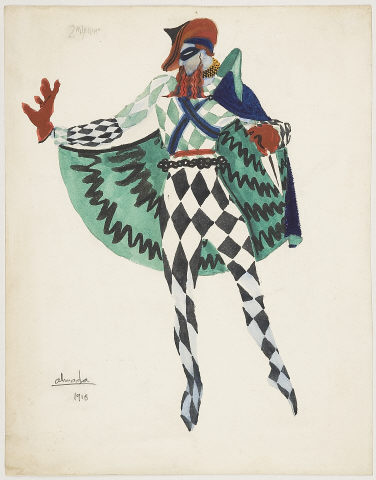
- 1918
- Paper
- Gouache
- Inv. DP180
José de Almada Negreiros
untitled
Between December 1917 and January 1918 the famous Ballets Russes performed in Lisbon. Almada was profoundly influenced by these shows and set out to create a series of ballets himself, acting simultaneously as choreographer, dancer, set designer and costume designer. This drawing, dated from 1918, is a costume design for – according to the inscription – the ‘2nd Murderer’, probably intended for the ballet A Lenda d’Ignez [The Legend of Inês]. This ballet was never performed, but announced in the manifesto Os Bailados Russos em Lisboa [The Ballets Russes in Lisbon], published in November 1917 in Portugal Futurista and signed by Almada, José Pacheco and the composer Ruy Coelho. There it is presented as a show that ‘would have interested Diaghilev [founder of the Ballets Russes] and his long-standing idea of a ballet about Inês de Castro’. According to the same manifesto, Almada had already designed sets and costumes, which ‘the great impresario [Diaghilev] seems to have brought with him, with promises of soon materializing them.’*
* See Vítor Pavão dos Santos, O Escaparate de todas as artes ou Gil Vicente visto por Almada Negreiros, Lisboa: Museu Nacional do Teatro, 1993, p. 20. On the ballet A Lenda d’Ignez, with music by Ruy Coelho, see Almada Negreiros e o espectáculo, exhibition catalogue, Lisbon: FCG/CAM, 1984.
SAF
May 2010
| Type | Value | Unit | Section |
| Height | 27,7 | cm | |
| Width | 21,7 | cm |
| Type | legend |
| Type | signature |
| Type | date |
| Type | Acquisition |
| Almada Negreiros e o Espectáculo |
| Lisboa, Fundação Calouste Gulbenkian, 1984 |
| Catálogo de exposição |
| Almada Negreiros e o Espectáculo |
| CAM/FCG |
| Curator: José Sommer Ribeiro |
| 22 de Agosto de 1984 a 14 de Outubro de 1984 Sala de Exposições Temporárias, do Centro de Arte Moderna. |
| A organização da exposição contou com a colaboração do Director do Museu Nacional do Teatro, Vitor Pavão dos Santos, e teve como objectivo mostrar uma das facetas de Almada Negreiros através da exposição de figurinos, maquetas de espectáculos e algum guarda-roupa. |